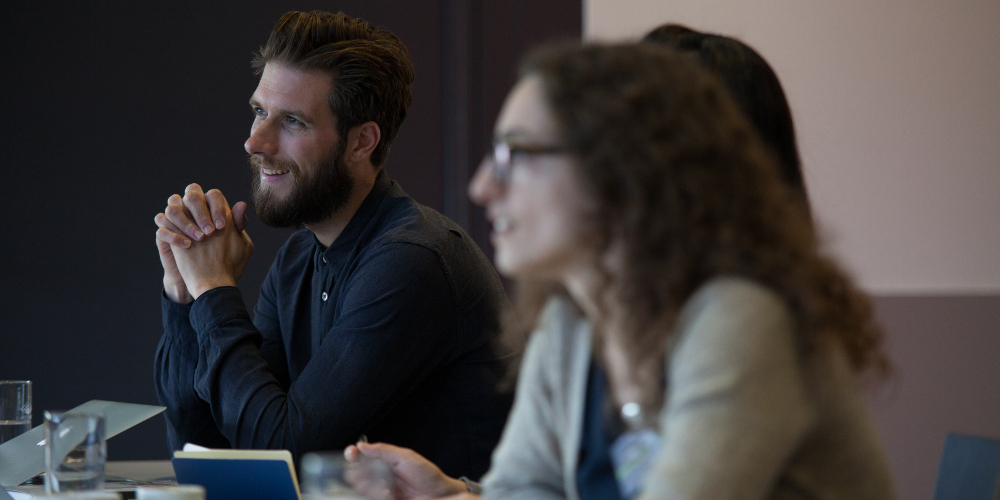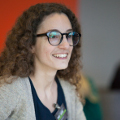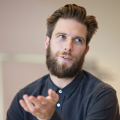 Michel van Dartel während during the jurymeeting in early May (Foto: Florian Voggeneder)
Michel van Dartel während during the jurymeeting in early May (Foto: Florian Voggeneder)
Curators Irini Papadimitriou and Michel van Dartel served as jurors in the Prix Ars Electronica’s Interactive Art category in early May. In this capacity, they viewed and evaluated a wide array of interactive works including installations, performances and net projects. Their approach to this assignment puts more emphasis on a well-thought-out concept and a great idea behind the work than on the mere beauty of the artistic representation. During the Prix Ars Electronica jury sessions, we had a chance to ask them what else they paid particular attention to in assessing the submissions. And we were also interested in their initial impression of the entries.
 Last year “Pendulum Choir”won the Golden Nica in the category Interactive Art – a choral piece where the choir stands on tilting platforms, constituting a living, sonorous body.
Last year “Pendulum Choir”won the Golden Nica in the category Interactive Art – a choral piece where the choir stands on tilting platforms, constituting a living, sonorous body.
Is there a trend this year as far as the projects’ themes are concerned?
Irini Papadimitriou: This year, we’ve received projects from many very diverse fields like data visualization and video projection. There’s also a lot of screen-based interaction. But what we find most striking is the large number of entries in the area of performance.
Michel van Dartel: That’s right. Another notable development is the large number of submissions having to do with hot trends of the past few years like drones, 3-D printers and so-called rebel technologies. These are all things that peaked a while back. So, in reaching our decisions, we’re making a concerted effort to give new trends a chance, though in many instances they’re spinoffs of things I just mentioned.
Irini Papadimitriou: We’re trying to avoid stuff that we encountered so often in previous years in the hope that this will ultimately enable us to come upon with something new and exciting.
 Irini Papadimitriou (Foto: Florian Voggeneder)
Irini Papadimitriou (Foto: Florian Voggeneder)
Is this trend towards performance evident throughout the interactive art genre or is the Prix Ars Electronica something of an exception here?
Irini Papadimitriou: You can see a lot of performances everywhere now. This is an area that’s growing very rapidly at the moment.
There are a tremendous number of submissions for prize consideration in the Interactive Art category. How do you deal with so many entries? What do you do to arrive at a decision?
Michel van Dartel: When you have to evaluate such a large number of submissions, you have to be very pragmatic. I make a constant effort to keep from getting bogged down so we can move forward quicker. Of course, it’s very tempting to examine a particular project in greater detail if it really grabs you the moment you set eyes on it, but this is the case with so many projects you encounter during the first two days that this approach would turn out to be counterproductive and you’d never get through them all. It’s imperative to keep discussions of individual projects to an absolute minimum at first. Then, when only a select few remain in contention, you can go into detail and consider each one comprehensively.
 The jury members of the Interactive Art category 2014 (Foto: Florian Voggeneder)
The jury members of the Interactive Art category 2014 (Foto: Florian Voggeneder)
The jurors in this category are experts from Chile, Greece, Spain, Japan and The Netherlands. Is this international diversity also the source of many differences of opinion?
Irini Papadimitriou: Not really. We’ve had several interesting discussions but, up to now, we’ve always managed to reach a consensus. We all have similar views and ideas about what we’re looking for in this category. We’re all very much interested in what’s behind these projects. We not only consider the entry’s interaction or participation; what we’re after is a really convincing idea behind the work. The social aspect of the respective project is also important to us. So, we’re all in agreement because we have similar views. And that itself is fascinating.
 Rain Room (Award of Distinction) is a 100-square-meter field of falling water through which it is possible to walk, trusting that a path can be navigated without being drenched in the process. (Foto: rAndom International)
Rain Room (Award of Distinction) is a 100-square-meter field of falling water through which it is possible to walk, trusting that a path can be navigated without being drenched in the process. (Foto: rAndom International)
Give us your impression of the quality of the submitted projects.
Michel van Dartel: The more you deal with these projects, the more cognizant you become of their quality. Initially, you can get only a rough overview of the entries, but as more and more are eliminated from consideration, you can increasingly focus on particular projects and, in doing so, maybe even come upon some interesting elements you had previously overlooked. For example, one project—and here I have to take care not to reveal too much about ones we’ve short-listed—the only reason that it even made it past the first cut is that we thought it was quite humorous. But as we went into it in more detail during our subsequent deliberations, the project’s qualities came out and everyone realized that it actually satisfied many of the criteria that we expect of a good work.
Irini has already mentioned interactivity, participation and social aspects. What other criteria does a successful project have to satisfy?
Michel van Dartel: To enable us to make good choices, we established several criteria that we deem especially important. In addition to interactivity, participation and the social aspect, they are innovativeness, the aesthetics, the quality of the concept and of the presentation, and, last but not least, of course, the fun factor.
 Maholo Uchida (Foto: Florian Voggeneder)
Maholo Uchida (Foto: Florian Voggeneder)
What advice would you give to artists who want to submit a project in this category?
Irini Papadimitriou: By all means, the project has to be well-thought-out. It’s not enough for the project itself to be good. It also has to have a strong idea, a good concept behind it. That’s what I pay particular attention to.
Michel van Dartel: That’s important to me as well. Entrants should definitely fill out the text field that’s provided on the website when you submit the project. Here, you should enter what inspired and motivated you to create this work. In this field, you should also give an account of your own position. Numerous entrants failed to go into these things this year. In most cases, people elaborate only on their artistic position. But we’d also like to know what kind of work the submission is based on or something about the project’s theoretical background. The lack of this information is a real problem in art sometimes. In scholarship, this is totally different. There are formal rules governing how to footnote sources you cite in a work. In my opinion, a similar structure should also be developed in art. This is the only way we can foster the dissemination of knowledge.

Irini Papadimitriou is a London-based curator and producer, currently Head of New Media Arts Development at Watermans, an arts organisation presenting innovative work and supporting artists working with technology, where she is curating the exhibition programme and an annual digital performance festival. Irini is also Digital Programmes Manager at the V&A, mainly responsible for programmes such as the annual Digital Design Weekend: a big-scale event of interactive installations, open & collaborative workshops, artists’ presentations and talks, showing digital art and design projects and offering audiences the opportunity to meet the artists & makers and explore processes. She is also one of the organisers for London’s Elephant & Castle Mini Maker Faire, a day of making, learning, inventing and tinkering.

Michel van Dartel is curator at V2, where he coordinates public events and is involved in a variety of artistic R&D projects. He also works as a freelance curator for a.o. the Dutch Electronic Art Festival, art center TENT, MU gallery, the Energize festival, and ARTICLE biennial. Besides curating, Michel is an author, tutor atLuca Brussels University College and CODARTS University for the Arts, researcher at Hanze University of Applied Science, associate editor of the Journal for Artistic Research, advisor to a.o. theMondriaan Foundation and Creative Industries Fund NL, and professional advisory board member at Piet Zwart institute andWillem de Kooning Academy. Michel holds an MSc in Cognitive Psychology and a PhD in Artificial Intelligence and currently lives in Rotterdam and Brussels.
